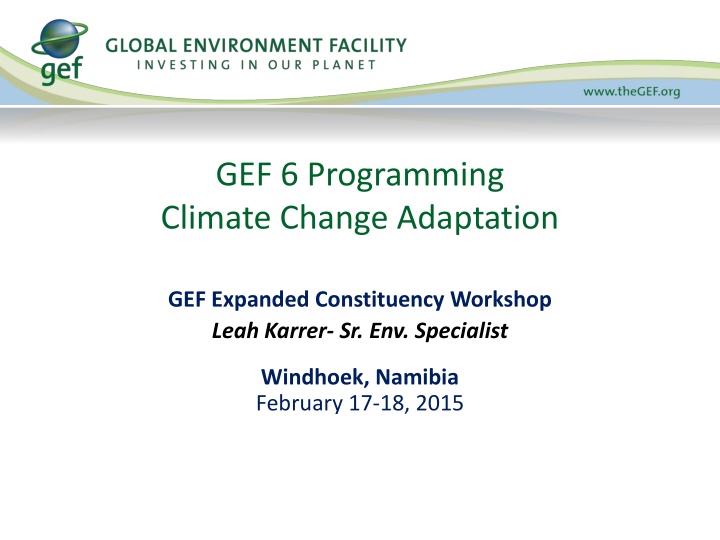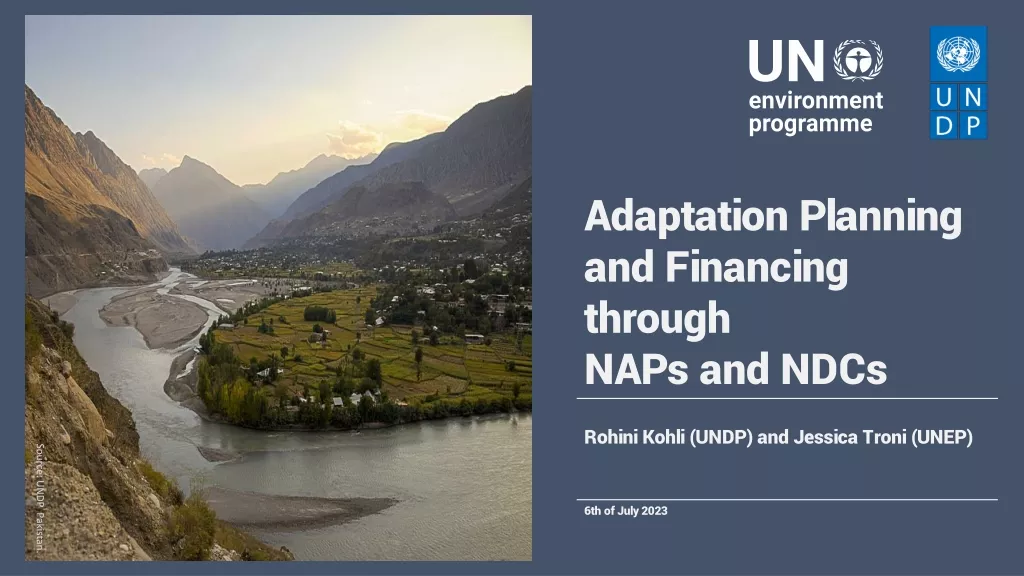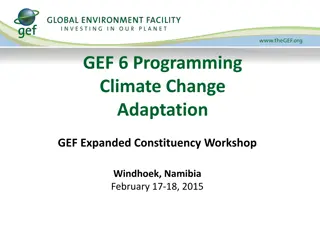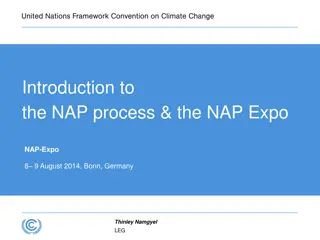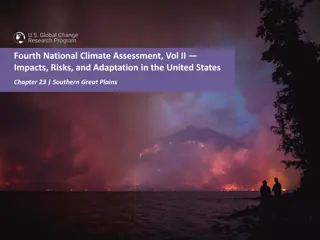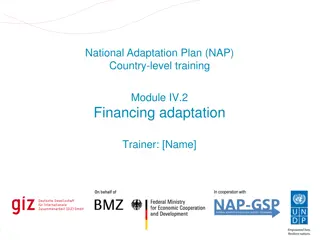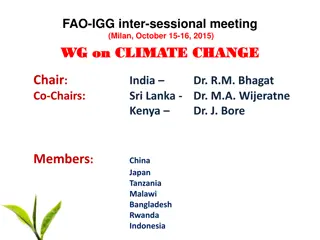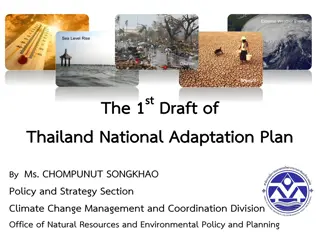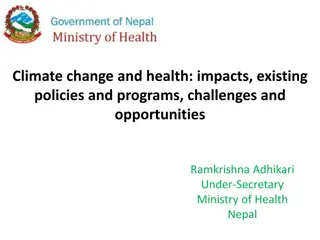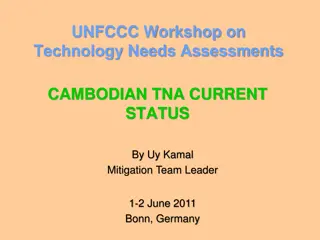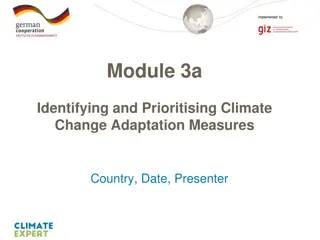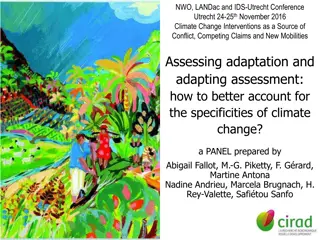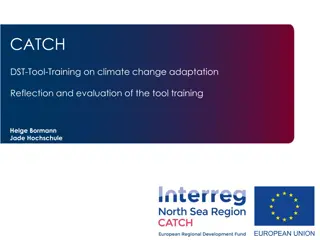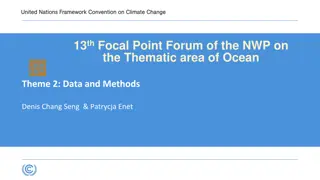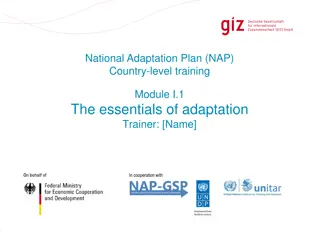Climate Change Adaptation Programming Strategies and Priorities
This content discusses the Global Environment Facility's (GEF) programming for climate change adaptation, focusing on strategies, funding sources, and thematic priorities. It outlines the goals, objectives, and core pillars of adaptation programming, emphasizing the integration of climate change adaptation into policies and programs. The strategies aim to reduce vulnerability, enhance resilience, and promote sustainable development in the face of climate change impacts across various sectors and regions.
Download Presentation

Please find below an Image/Link to download the presentation.
The content on the website is provided AS IS for your information and personal use only. It may not be sold, licensed, or shared on other websites without obtaining consent from the author.If you encounter any issues during the download, it is possible that the publisher has removed the file from their server.
You are allowed to download the files provided on this website for personal or commercial use, subject to the condition that they are used lawfully. All files are the property of their respective owners.
The content on the website is provided AS IS for your information and personal use only. It may not be sold, licensed, or shared on other websites without obtaining consent from the author.
E N D
Presentation Transcript
GEF 6 Programming Climate Change Adaptation GEF Expanded Constituency Workshop Leah Karrer- Sr. Env. Specialist Windhoek, Namibia February 17-18, 2015
GEF- 6: Programming & Funding Sources GEF Trust Fund: STAR Allocation GEF Trust Fund: Non-STAR Allocation LDCF / SCCF Biodiversity (BD) X Land Degradation (LD) X Climate Change Mitigation (CCM) X International Waters X Chemicals & Waste X Integrated Approach Pilots (IAPs) X X Sustainable Forest Management (SFM) X X Climate Change Adaptation (CCA) X
Adaptation Programming Strategy: LDCF & SCCF LDCF Least Develop Countries Fund Southern Africa eligible countries: Angola, Lesotho, Malawi, Mozambique, Zambia SCCF Special Climate Change Fund Southern Africa eligible countries: All
Adaptation Programming Strategy: Goal & Objectives 1) Reduce the vulnerability of people, livelihoods, physical assets and natural systems Goal: increase resilience to the adverse impacts of climate change in vulnerable developing countries, through both near- and long-term adaptation measures in affected sectors, areas and communities 2) Strengthen institutional and technical capacities 3) Integrate climate change adaptation into relevant policies, plans and associated processes
Adaptation Programming Strategy: 2 Core Pillars & Innovations Pillars: 1) Integrating CCA into relevant policies, plans, programs LCDF: implementation of National Adaptation Programmes of Action 2) Pursing initiatives that cut across both adaptation and other GEF focal areas. Innovations: Private sector engagement & Ecosystem-based adaptation
Adaptation Programming Strategy: Thematic Priorities Agriculture and food security Water resources management Coastal zone management Infrastructure Disaster risk management Natural resources management Health Climate information services Climate-resilient urban systems Small Island Developing States
GEF 6 Programming International Waters GEF Expanded Constituency Workshop Leah Karrer- Sr. Env. Specialist Windhoek, Namibia February 17-18, 2015
GEF- 6: Focal Areas & Funding Sources GEF Trust Fund: STAR Allocation GEF Trust Fund: Non-STAR Allocation LDCF / SCCF Biodiversity (BD) X Land Degradation (LD) X Climate Change Mitigation (CCM) X International Waters X Chemicals X Integrated Approach Programs (IAPs) X X Sustainable Forest Management (SFM) X X Climate Change Adaptation (CCA) X
International Waters: transboundary river basins, lakes, aquifers, large marine ecosystems & open oceans
International Waters Approach Transformational Change Implementation of Strategic Action Program Development of Regionally-Agreed Strategic Action Program Foundational Capacity Building / Enabling Environments, Basic Policy and Cooperation / Issue Identification
International Waters GEF- 6 Strategy Goal: To promote collective management of transboundary water systems and implementation of the full range of policy, legal and institutional reforms and investments contributing to sustainable use and maintenance of ecosystem services Objective 2: Balance Competing Water-uses in the Management of Transboundary Surface and Groundwater Objective 3: Rebuild Marine Fisheries, Restore and Protect Coastal Habitats, and Reduce Pollution of Coasts and LMEs Objective 1: Catalyze Sustainable Management of Transboundary Waters 1. Foster Cooperation for Sustainable use of Trans- boundary Water Systems & Economic Growth 3. Advance Conjunctive Management of Surface & Groundwater systems 5. Reduce Ocean Hypoxia 6. Prevent the Loss and Degradation of Coastal Habitat 2 .Increase Resilience & Flow of Ecosystems Services in Context of Melting High Altitude Glaciers 4. Water/Food/Energy/ Ecosystem Security Nexus 7. Foster Sustainable Fisheries
